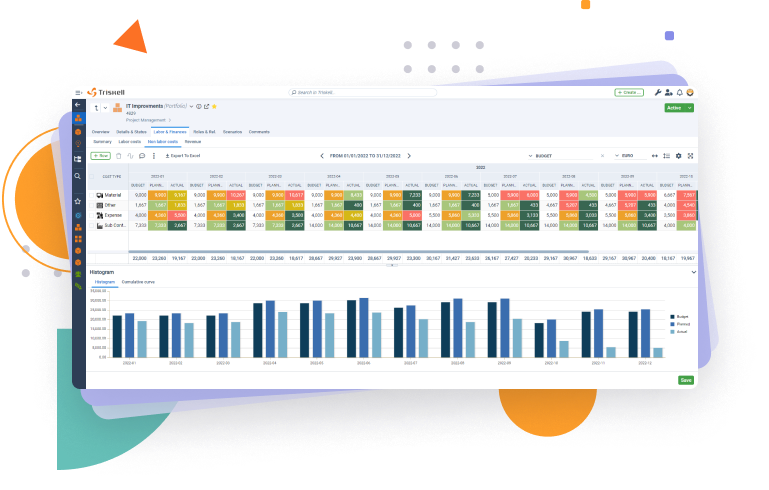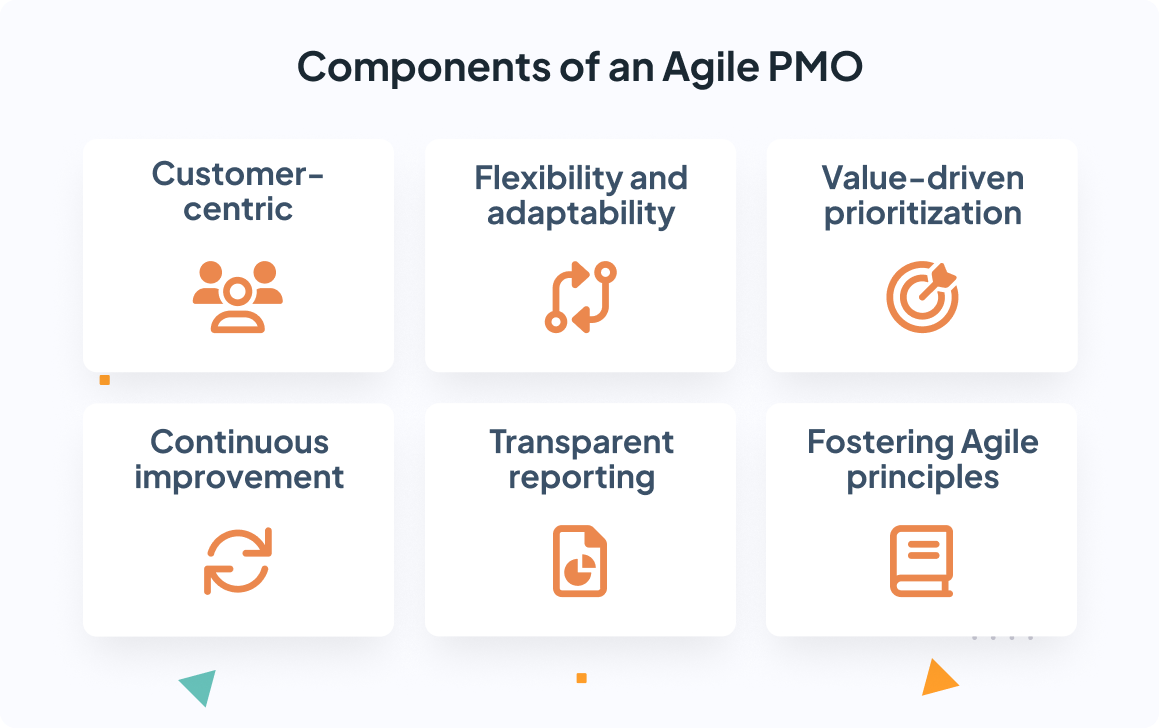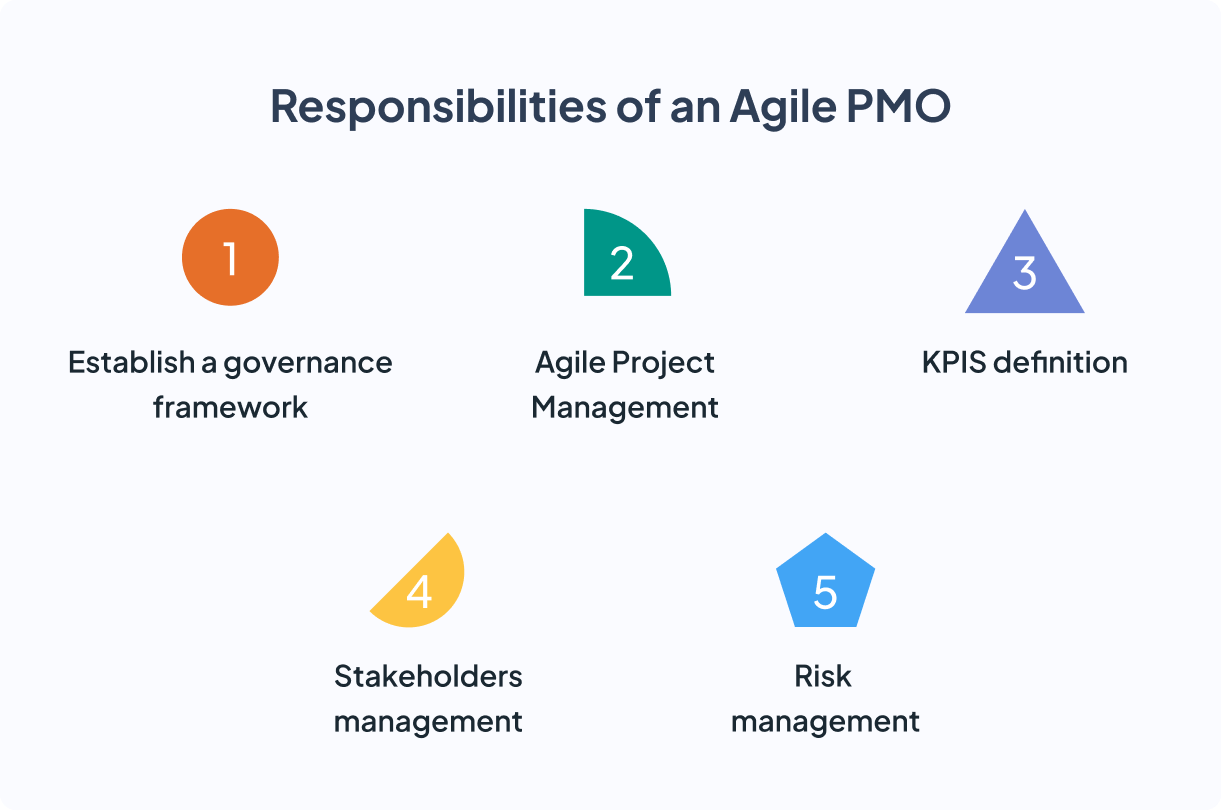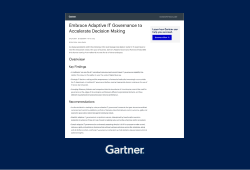Building a value-driven Agile PMO: proven strategies for success

In today’s business landscape, companies must become more agile if they want to succeed. To adapt to ever-changing market demands and gain a competitive advantage, Agile Portfolio Management frameworks are more necessary than ever.
It is in this context that the Agile PMO emerges. A new approach that redefines the role of the traditional PMO and makes it one of the main agents of change and innovation in companies. In this post, we will explore the concept of the Agile PMO in depth, and break down its key components, responsibilities and benefits. We will also discuss the most common challenges in implementing it and how to address them successfully.
The role of PMOs in Agile organizations
Agility is not something that is achieved overnight. It is a road full of obstacles and not all organizations end up succeeding.
In this transition to agility, PMOs can play a very important role as a driver of change. But to do so, it must transform its approach. Instead of being a purely administrative and bureaucratic entity, the PMO must act as a strategic catalyst to drive innovation, efficiency and continuous improvement in delivering value to customers.

AGILE PORTFOLIO MANAGEMENT
Empower your Agile PMO with value-driven insights
See how Agile PMOs can leverage Triskell’s capabilities
The PMO can facilitate this transition to Agile in a variety of ways. Here are some of them:
- Leading the cultural transformation necessary for the organization as a whole to adopt an Agile mindset. To do this, you must promote openness to change, experimentation and continuous learning at all levels.
- Collaborating closely with the organization’s teams and leaders to effectively implement Agile practices. It should facilitate the adoption of methodologies such as Scrum, Kanban or Lean and adapt them to the specific needs of the company.
- Promoting communication and collaboration between teams. It must act as a bridge between different departments, facilitating alignment and knowledge sharing.
What is an Agile PMO?
So, in Agile environments, or in organizations that have begun that transformation to agile, they require Agile Project Management Offices to help drive that shift to agile practices. But what really is an Agile PMO?
A traditional PMO is considered an organizational unit that provides support and oversight in managing projects and programs. Its main function is to standardize processes, improve efficiency and ensure the success of projects by implementing specific practices and workflows.
Agile PMOs are also responsible for facilitating and overseeing the implementation of Agile practices in an organization. In contrast to traditional management offices, with more rigid and hierarchical management and governance processes, Agile PMOs place special emphasis on flexibility, value delivery and continuous adaptability, these 3 elements being their main hallmarks.
Agile PMOs are based on values such as collaboration, flexibility and continuous value delivery
Components of an Agile PMO
An Agile PMO, in order to be effective and deliver value to the business, must be underpinned by a set of principles that, taken together, will help promote agility and success in managing the organization’s portfolios. These components are critical to ensure that the PMO is aligned with Agile principles and practices and can adapt to changes in the business environment.
These are the 6 components of an Agile PMO.
Customer focus
This component is one of the cornerstones not only of an Agile PMO, but of Agile principles themselves. Instead of focusing solely on meeting the organization’s internal objectives, customer satisfaction becomes the top priority. It’s about generating real value for those you are targeting, whether they are internal or external customers.
And how do you achieve this? You must establish fluid communication with customers, constantly gathering their feedback, and adapting projects to their changing needs. This is the only way to ensure that you are delivering what really adds value.
Flexibility and adaptability
Agile methodologies are characterized by their ability to adapt to change. And the Agile PMO is no different. Forget rigid structures and inflexible processes. Here it’s about flowing with market changes, new technologies and the needs of the business itself. Therefore, processes and methodologies must be flexible and adaptable to the specific needs of each initiative.
The key is to foster a culture of experimentation and continuous learning, where teams feel comfortable trying new ideas and learning from their mistakes.
WHITE PAPER
Agile Portfolio Management – Agility by delivering changes as business as usual
Prioritization and value-driven delivery
Not all projects carry the same weight. And that is why an Agile PMO must focus on identifying and prioritizing those initiatives that really bring value to customers and the business. The goal? To deliver products, services and functionalities of value to the customer in the shortest possible time, but without sacrificing quality. This implies leaving aside initiatives that consume resources and do not generate tangible benefits.
How to achieve this prioritization focused on value delivery? You must use analysis and evaluation tools to determine the potential value of each project. In this way, efforts will be invested in what truly drives business growth.
Continuous improvement
Continuous improvement is another fundamental pillar of an Agile PMO. It is based on the idea that processes and practices can be constantly improved through iteration and feedback.
And how can the PMO foster continuous improvement?
- By implementing short improvement cycles: you should plan, execute and evaluate the progress of each initiative in short cycles to identify opportunities for improvement.
- Gathering regular feedback from customers, teams and stakeholders to understand their needs and expectations.
- Encouraging experimentation with new ideas and methods to come up with innovative solutions.
Transparent reporting
Transparency in communication is crucial for a successful Agile PMO. It must provide open access to all relevant information from product and project portfolios to all stakeholders. This includes organizing stand-up meetings where progress, next steps, risks and challenges faced by the teams are communicated.
This approach gives team members a way to engage with the work they will be doing themselves. It also allows them to support the team’s commitments, including unblocking roadblocks that prevent the work from being completed.
Boost efficiency and gain portfolio visibility
Request a demo today and see how Triskell can streamline resource allocation, provide real-time visibility across your portfolio, and empower your Agile PMO for success.
Fostering Agile culture
The PMO should be one of the main drivers for the implementation of Agile methodologies. These methodologies, such as Scrum and Kanban, allow organizations to adapt to change with ease because they are based on 4 basic principles:
- Collaboration.
- Transparency.
- Individual accountability.
- Incremental delivery of value.
To carry it out, the PMO must train the teams in these methodologies. In addition, a project tracking system should be implemented that includes regular meetings to evaluate progress and make adjustments on the fly.
Agile PMO vs traditional PMO
Therefore, the differences between a traditional strategic PMO and an Agile PMO lie not so much in their objectives, but in their approach, method and outcomes.
The Agile PMO does not replace the traditional PMO, but complements and transforms it
Both seek excellence in managing an organization’s projects and products, but differ in their approaches and how they address the challenges of today’s business environment.
Approach
As a general rule, traditional PMOs focus on planning, control and detailed documentation of projects, following a linear and sequential approach.
In contrast, Agile PMOs take an iterative and adaptive approach, prioritizing incremental value delivery and rapid response to change.
Hierarchy and collaboration
In a traditional PMO, both the chain of command and the roles and responsibilities are perfectly defined in their workflows.
However, Agile PMOs encourage collaboration, self-organization and empowerment of teams, promoting decentralized decision making and shared responsibility.
Documentation vs. value delivery
Traditional PMOs place a heavy emphasis on documentation, often to the detriment of rapid delivery of value to the customer. An agile PMO, on the other hand, prioritizes early and continuous delivery of value to the customer, minimizing unnecessary documentation and prioritizing effective communication.
This table, as a summary, defines very well the main differences between a traditional PMO and an Agile PMO:
Aspect |
Traditional PMO |
Agile PMO |
|---|---|---|
|
Focus |
Sequential and predictive. |
Iterative and incremental. |
|
Flexibility |
Less flexible and adaptable to changes. |
Highly flexible and adaptable to changes. |
|
Collaboration |
Hierarchical, with clearly defined roles and responsibilities. |
Hierarchical, with clearly defined roles and responsibilities. |
|
Documentation |
Extensive and detailed. |
Lean and focused on outcomes. |
|
Value delivery |
At the end of projects. |
Early and continuous. |
Responsibilities of an Agile PMO
An Agile PMO, as part of its role as a driver of change within an organization, has several responsibilities crucial to its effectiveness in implementing Agile practices.
These responsibilities cover different aspects, from creating a coherent governance framework, or establishing KPIs and relevant metrics to evaluate the performance of projects with Agile frameworks. We explain them below.
Establish a Governance model
The first task that a PMO operating in an agile environment must undertake is to define a clear and effective governance model. This implies:
- Defining precisely the roles and responsibilities of the different actors involved in the management of the organization’s project and product portfolios.
- Establishing the decision-making mechanisms that will guide the execution of all these initiatives.
This governance model must provide the necessary structure so that projects and products are executed in a coherent manner and aligned with the strategic objectives of the business.
Agile project management
In addition to establishing a governance framework, the PMO should lead the implementation of some of the agile practices, such as:
- Iterative planning.
- Incremental delivery.
- Multidisciplinary collaboration.
The PMO will be responsible here for providing support and guidance to the teams and organizational areas involved in managing the organization’s portfolios. It must identify and remove those obstacles that impede the proper performance of the teams, and help them to solve problems and make efficient decisions.
KPI definition and tracking
The PMO must also establish KPIs and metrics to help evaluate not only the performance and success of an organization’s product and service portfolios, but also to analyze how well Agile practices are working in the organization.
These KPIs must also be aligned with the company’s strategic objectives and allow:
- Track project progress against established KPIs. Make informed decisions at the project, program or portfolio level.
- Identify areas for improvement and optimize management processes.
Among the metrics worth analyzing, we can include the following:
- Cycle time: this is the time it takes a team to complete a task from start to finish. It helps to measure the efficiency of the development and delivery process.
- Burn-down chart: is a graph that shows the amount of work remaining in a sprint over time. It helps teams visualize whether they are on track to complete the work planned for the sprint.
- CSAT: is calculated through surveys that measure customer satisfaction with the delivered product or service.

AGILE PORTFOLIO MANAGEMENT
Align strategy and drive Agile success
Learn more about Triskell’s PPM solutions
Stakeholder management
Stakeholder management is an integral part of Project Management offices. And, in the case of the Agile PMO, it should be no less. It must identify all relevant stakeholders (teams, sponsors, suppliers, executives, end users, etc.) and understand the needs, concerns and expectations of each of them.
Once identified, the PMO manager must be responsible for establishing and maintaining effective communication with all of them. To this end, a communication plan is created to keep them informed, regular meetings are held to present progress and expectations are proactively managed.
Risk Management
The Agile PMO focuses not only on success, but also on preventing problems. By identifying, assessing and mitigating potential risks that may affect the project, proactive measures are taken to avoid mishaps. This is achieved through:
- A risk analysis at the beginning of each project.
- The implementation of a risk management plan.
- Continuous monitoring of projects to identify new risks that may arise.
In addition, it is recommended that the teams are also aware of these risks. And, if necessary, provide them with training or best practices in Risk Management so that they are able to foresee and manage them themselves.
Benefits of a Value-Driven Agile PMO
An Agile PMO with a focus on value delivery transforms project management and generates benefits for the organization, teams and customers. These benefits go beyond completing tasks on time and on budget, they focus on tangible results that drive business growth and competitiveness.
These are the main benefits of an Agile PMO:
- Increased delivery speed: projects are completed faster through incremental delivery of value and elimination of unnecessary processes.
- Improved quality: by fostering a culture based on collaboration and transparency, errors are identified and corrected early.
- Increased customer satisfaction: thanks to Agile PMO’s focus on customer needs and the delivery of real value.
- Reduced costs: by optimizing processes and eliminating bottlenecks you will reduce project costs.
- Greater flexibility and adaptability: agility allows you to adapt to changes in markets and changing business needs.
Overcoming most common challenges when implementing an Agile PMO
But not all are benefits when implementing an agile PMO. There are many challenges that the PMO manager will encounter in this transition to agility, but we will summarize them in 5:
- Resistance to change.
- Organizational culture.
- Lack of knowledge.
- Scalability.
- Governance.
Let’s now look at how to solve each of these challenges.
Resistance to change
Resistance to change is a natural reaction against the introduction of new management practices and processes in an organization. And this happens, unsurprisingly, in any organization trying to transition to agility.
To overcome this challenge, the PMO can take some of these actions:
- Communicate clearly and transparently the reasons for and benefits of adopting Agile principles. This will help mitigate the fear of change and build confidence in the teams.
- Involve stakeholders from the beginning and listen to their concerns, thus gaining their commitment and support for the change.
- Show tangible benefits and outcomes early in the process of implementing Agile principles.
- Provide adequate training and support for all teams to acquire the necessary skills and knowledge to work effectively in an agile environment.
Organizational culture
The culture of the organization can, in some cases, be your best ally in getting the PMO to drive agility. But unfortunately, in most cases it poses an obstacle to successfully implementing agility. If the organizational culture is rigid, bureaucratic and resistant to change, this can make it very difficult to adopt agile values and principles.
Here are some strategies your PMO can undertake to address this challenge.
- Conduct an organizational culture assessment to identify those elements that could hinder agile implementation.
- Involve business leaders in the process so they lead by example and demonstrate to everyone their commitment to Agile principles.
- Promoting an environment where collaboration, experimentation and continuous learning are encouraged.
- Recognize and celebrate successes achieved through agile implementation to motivate all teams to move forward with the cultural change.
Lack of knowledge
Lack of knowledge about Agile methodologies can represent a major obstacle to implementing agile in an organization.
To overcome this hurdle, the PMO can:
- Provide the necessary training and education to help close that knowledge gap and prepare teams and departments to work efficiently in an Agile environment.
- Offer mentoring and coaching programs so that more experienced employees can guide those who are new to Agile methodologies.
- Facilitate access to learning resources for teams to continue their professional development and expand their knowledge of Agile methodologies.
Scalability
As organizations grow and their portfolios diversify, scalability challenges can arise when trying to implement Agile across different areas of the business. Lack of standardization in processes, silos, resistance to change in some departments, or the complexity of coordinating multiple teams on large-scale initiatives can make it difficult to scale Agile in an organization.
In order to scale Agile in an enterprise, it is necessary to:
- Define clear and documented processes: a solid foundation of standardized processes for Agile project management must be established to ensure consistency and quality in value delivery.
- Implement tools that facilitate collaboration and communication: use cloud-based PPM tools that enable seamless communication between teams, real-time progress tracking and efficient task management.
- Measure and monitor progress to identify areas for improvement: collect key data and metrics to identify areas for improvement and adjust the strategy when necessary.
Governance
Finally, for an agile PMO to be successful, it must establish a well-defined structure that establishes roles, responsibilities and processes for decision making. Without clear governance, the PMO can lose its direction, generate confusion and be inefficient.
To establish good governance mechanisms, it is recommended to:
- Define a steering committee, which will be responsible for overseeing and supporting the PMO. It should be composed of representatives from different teams and areas of the company.
- Clearly document the role of the PMO within the organization, including its functions, objectives and responsibilities.
- Establish a framework for agile decision making, which should include the participation of key stakeholders and mechanisms for effective conflict resolution.
- Ensure that the PMO operates in a transparent manner, being accountable to stakeholders for its performance, results and use of resources.
How Hybrid PPM can help organizations to embrace Agile practices
At this point, and after weighing the benefits and challenges of implementing Agile, it is clear that Agile comes out on top. But it’s not all that simple. Not all organizations are ready to adopt Agile, and this change is not something that can be undertaken overnight.
What if the solution is to integrate Agile without completely abandoning your traditional project management processes? Hybrid project management approaches give you the flexibility you need to adopt Agile more gradually without giving up the methodologies you work with most in your organization.
WHITE PAPER
Interfacing between Linear Waterfall and Agile Approaches
If you are considering implementing Agile practices in your company, a hybrid approach may be the best option. It allows you to take advantage of the benefits of Agile without having to make a radical change to the way you work.
Hybrid approaches can facilitate a gradual transition to Agile, reducing resistance to change and allowing teams to gradually adapt to new practices. It is an ideal approach for teams familiar with Waterfall, as it will minimize their learning curve and sense of uncertainty.
Advantages of hybrid project management:
- Flexibility and adaptability: you will respond quickly and efficiently to market changes and client needs.
- Efficiency and control: you will maintain the structure and planning necessary for complex projects without losing agility.
- Risk management: by combining the predictability of traditional methodologies with the flexibility of Agile, you will minimize the impact of risks on ongoing initiatives.
- Dependency management: facilitates coordination between teams working with different methodologies, which helps identify and resolve dependencies effectively.
Conclusion
In summary, Agile is not only a new way of managing projects, but a change of mentality and a cultural transformation that is driving companies of all sizes and sectors towards success. And, in this context, the PMO must become one of the engines of your business transformation, driving the adoption of agile practices throughout the organization.
Agility is not a goal, but a continuous path of learning, adapting and improving
But, if you want your company to embark on this new course, you must remember the following: agility is not a fixed destination, but a continuous path of learning, adaptation and improvement. And the PMO must be the guide that helps the organization to successfully navigate this path.
Boost efficiency and gain portfolio visibility
Request a demo today and see how Triskell can streamline resource allocation, provide real-time visibility across your portfolio, and empower your Agile PMO for success.

Related Content

ESG principles, frameworks and best practices for Project Management
Align projects with ESG principles. Learn how companies use frameworks like GRI & SASB to meet sustainability goals and improve compliance.

10 types of Project Management Offices (PMO): structure, purpose and how to choose the right one
Learn about different PMO types, their governance levels, and which one is the best fit for your company’s project management needs.

How to create a project budget: methods and techniques for effective project budgeting
Learn how to create a project budget with this detailed guide. Discover essential methods and techniques for effective project budgeting in PPM.
FAQs about Agile PMO
Can an Agile PMO coexist with traditional project management methods within the same organization?
Yes, an Agile PMO can coexist with traditional project management methods through a hybrid project management approach. This allows the organization to gradually integrate Agile practices while retaining elements of traditional methods where necessary.
A hybrid approach is particularly beneficial for organizations not ready for a full-scale Agile transformation, providing flexibility and reducing resistance to change.
How does an Agile PMO contribute to enhancing customer satisfaction?
An Agile PMO enhances customer satisfaction by prioritizing customer-centric value delivery. This involves maintaining constant communication with customers, gathering feedback, and adapting projects to meet their evolving needs.
By focusing on delivering tangible value early and continuously, an Agile PMO ensures that the end products or services align closely with customer expectations, leading to higher satisfaction levels.
How does an Agile PMO support continuous improvement within an organization?
An Agile PMO drives continuous improvement by implementing short iterative cycles, gathering regular feedback, and encouraging experimentation with new ideas.
This approach ensures that processes are consistently evaluated and refined based on real-time data and stakeholder input, allowing the organization to remain agile and responsive to market demands.



